
























www.allmakes4x4.com

We’re on Facebook: www.facebook.com/thelandyuk To advertise in The Landy, call our team on 01283 742969




























www.allmakes4x4.com

We’re on Facebook: www.facebook.com/thelandyuk To advertise in The Landy, call our team on 01283 742969



THE NEW DEFENDER OCTA WILL COST FROM £145,300 WHEN THE ORDER BOOK OPENS AT THE END OF JULY. And the Octa Edition One, whose availability will be limited to the first year of production, is set to take the price still higher to £160,800.
Powered by the 4.4-litre twin turbo V8 from the Range Rover Sport, the Octa is SVO’s take on the Defender 110. The engine delivers 635bhp and 553lbf.ft – figures which translate into a 0-60 time of just 3.8 seconds and, when equipped with 22” road tyres, a top speed of 155mph.
This doesn’t make it quite as fast as some of its similarly priced rivals in
the ultra-SUV market. However JLR promises that unlike them, it will be ‘as fun to drive on-road as off-road, with no compromises.’
Helping it achieve this, the vehicle receives major revisions to its chassis and suspension. Longer wishbones widen its track by 68mm and raise its height by 28mm while promising ‘both maximum wheel articulation off-road and reduced roll on-road.’ Aiding it here is 6D Dynamics, a system using hydraulically-interlinked semi-active shocks to reduce pitch and roll almost to zero while also freeing up more suspension movement in off-road use.
As always these days, the vehicle’s


“Tea



hardware is trimmed by a palette of drive modes. The vehicle can also detect the terrain under its wheels for itself and choose its own settings automatically – however if you take charge using the mode menu, Dynamic Mode provides ‘the ultimate performance-focused on-road experience, tuning the vehicle’s steering, throttle and suspension settings with one press of the transparent signature logo button on the steering wheel.’
The off-road equivalent is Octa mode, which allows ‘off-road driving with a performance focus.’ Shades of the Baja mode on the Ford Ranger Raptor, obviously. Features include Off-Road Launch, allowing for fast take-offs on loose terrain, and there’s also the usual range of options in the now-familiar Terrain Response menu. The Octa’s 400mm front brake discs and Brembo calipers, as well as the fastest steering ratio of any Defender to date, help allow it to be as controllable as it is biddable.
It’s also every bit as imposing as you’d expect. In addition to its higher, wider stance, it’s the first Defender equipped with 33” tyres – meaning enhanced bodywork to keep it legal. Extended wheelarches flow into the vehicle’s ‘off-road-optimised front bodywork’ (hands up if you thought the old Defender had that) with unique grilles















to allow greater under-bonnet airflow. The rear bumper houses quad-pipe active exhaust finishers and there are exposes recovery points front and rear, as well as ‘tough underbody protection including an aluminium alloy front under shield with graphite finish.’ When you took out your Disco Tdi’s sump on a rock that time, what you really needed was a graphite finish.
Another difference between this Defender and all those old bits of junk from when Land Rover made things you could afford is that you won’t be slinging a set of 7.50s on it and going out to have fun. Those 33” tyres include an Advanced All-Terrain developed by Goodyear specifically for the Octa. Colours? They matter, because if you’re doing two grand a month on this thing you want everyone to notice that you can afford it. The choices include
Petra Copper and Faroe Green, both premium metallic finishes which are exclusive to the Octa; the latter is in fact so exclusive to the Octa that it’s exclusively exclusive to the Octa Edition One.
So too is Chopped Carbon Fibre detailing. Used on the vent surrounds on the bonnet and, they actually said this, ‘fenders’ (the word is WINGS, thank you), as well as the Defender bonnet script and, in the cabin, on the centre console trim and front seatbacks, this is ‘a highly distinctive finish which includes recycled raw materials.’ Recycled raw materials. Take a minute to get your head around what that one could even mean.
Since we’ve started on the cabin, it might worry you that we’ve made it this far without the C-word cropping up. But don’t worry, the people at JLR haven’t
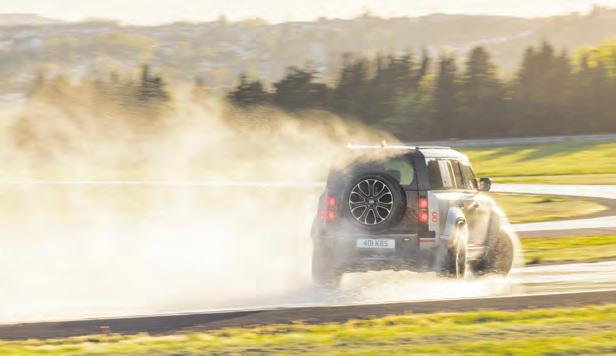
lost sight of what made Land Rovers great. ‘Inside, curated (hurrah!) selections set New Defender OCTA apart.’ These include a hand-painted roof by Michelangelo and artfully soiled rear seats by Tracey Emin. Oh, hold on. You can curate your Defender by choosing from two Ultrafabrics seat options in lieu of the standard leather. Or they’re standard on the Edition One. Now, that’s what you call curatorial. Those seats are unique to the Octa, with more supportive bolsters and integrated headrests. Additionally, ‘Defender’s close association with music (answers on a postcard) is brought to the fore with immersive Body and Soul Seat audio technology… allowing the driver and front passenger to feel, as well as hear, the music.’ To be fair, this would have been very useful back in the days when listening to music in a Defender was an exercise in trying to hear anything above the non-stop noise. Additionally, ‘six wellness programmes are available to help relax occupants or improve cognitive responses on the move,’ which sounds clever.
If you really want wellness, though, we refer you back to that engine. And to the notion of Off-Road Launch Control, even if it sounds like the gimmick to end all gimmicks unless you live in Dubai or somewhere like that. Which a good proportion of Octa customers probably will.
















The Institute of Public Rights of Way recently held a ‘Regional Development Day on Managing Off Road Activities.’ This rang alarm bells within the Green Lane Association (GLASS); the term ‘off road’ is often used incorrectly, encouraging people to view responsible rights of way use as being no different to illegal and damaging off-roading on private or public land.
Within GLASS, it was felt that the association should seek the opportunity to be represented. With the help of a friend, Wiltshire rep John Lipiatt was offered an invitation to attend from the Defence Infrastructire Organisation (DIO), which was hosting the event at the MOD’s Westdown Camp premises.
‘Although grateful for the invite,’ reports John in the June issue of GLASS’ Green Lanes Bulletin, ‘I must admit to feeling a little trepidatious at the thought of being the only user representative among officers from nine Local Authorities. But they were all friendly and I think it fair to say that they were as surprised to see me as I was to be there.
‘The meeting started with an introduction from the Chairman and a welcome from the Senior Public Access
and Recreation Advisor for the DIO.
There followed a presentation explaining the unique environment of Salisbury Plain, its areas of SSSI and some of the creatures that inhabit it.
‘After a quick question and answer session, we all went out on a field visit.
The first location was at the south east corner of Chitterne Down, to a lane which was diverted some eight years ago. The old route was presented as an example of damage through misuse.
From a vantage point on the new route, it could be seen where parallel tracking had taken place and some commented that the ground might not recover within any of our lifetimes.
‘Turning to the new route, there was evidence of minor parallel tracking around what I know to be an easily driven puddle. I made the point that with local knowledge, signage and the use of navigation systems such as TrailWise 2 and Memory Map, one would know that the defined route could be kept to.
‘Many present were trying to confirm their location using mobile phones running mapping that showed them in the middle of nowhere. My being able to locate us accurately seemed of great


interest. I also pointed out that with many tracks that were not rights of way, good navigation and signage were key to keeping people where they should be and to that end the Green Lane Association is heavily involved in the voluntary signage group.
‘The second location, more or less central within Chitterne Down, was presented as what could be achieved by collaborative working between landowners and the local authority. This is the lane south of Copehill Down (German Village) and is a good example of how a well maintained route is of no interest to the illegal user.
‘Discussion of the use of road planings for lane repair took place, with many approving of their use, liking the fact that the grass soon starts to grow up through the middle. It was lucky that, in the case of this lane, it was just outside of the SSSI area, otherwise it could not have been used.
‘We had a brief demonstration of a Mexe Probe Penetrometer by the Kent rights of way team. This tests the resistance of a surface to penetration, the results of which can be applied to calculate the ability of a road to support
weight. The discussion was cut short as we had to return to Westdown for lunch.
‘The lunch break gave the opportunity for more casual conversation and I was pleased that many knew and thought well of their Association reps.
‘After lunch, there was a presentation by the current commandant for Salisbury Plain Training Area, which was very interesting and carefully prepared. It cited various illegal gatherings, notably with pictures of a day out organised by a tour company a couple of years ago where 100-plus 4x4s turned up after they lost control of the event due to posting the start/meeting point on social media. Many concerned users, myself included, tried to stop this to no avail.
‘He also had drone footage of illegal use of military driver training areas and recounted stories of vehicles still registered to previous owners, making it difficult to prosecute offenders.
‘He then moved on to explain the issues that the MOD have with all classes of user including dog walkers, who are obviously operating a business and don’t clear up their mess, equestrians in the wrong place, cyclists who ride in wood blocks, motorcyclists who turn up


with van loads of illegal bikes and then don’t stop when requested, and then back to the 4x4’s. Through all of this, he was very careful to acknowledge the rights of legitimate users and ended by asking what he can do to control things.
‘The Salisbury Plain Rights of Way Volunteer group coordinator then gave a presentation showing the work we have done (the Association are members of this group) over the last 15 years to improve signage and waymarking of the Plain, there now being over 500 posts with approximately 1800 fingers enabling the public and the military to gain ‘Certainty, Clarity and Consistency’ over access rights.’
The event concluded with an informal discussion of the problems faced by rights of way officers – with many voicing their frustration at measures taken to try and control illegal off road activities with very limited success.
‘I was pleased that this part of the meeting seemed centred on all forms of illegal usage, not just 4x4s,’ reflects John. ‘I hope that my input into the discussions will have reinforced belief that responsible users and user groups can and will help to maintain access for all.’




All we want is to be taller and wider…
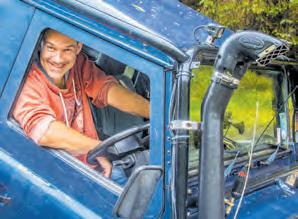
It’s common for people who own oldshape Defenders to sneer at the new one. Still, after all this time. I see it all the time on social media: ‘You’ve got the wrong group, mate, this one’s for proper Land Rovers’ and so on.
If you share that point of view, you’ll have rolled your eyes at our story about the Defender Octa and probably flicked past it without reading. It’s easy to mock when you see a 635bhp Defender worth more than many houses (we should know; read the article and you’ll see that that’s exactly what we did), but JLR is doing it because people want it.
And ultimately, despite its loony-tune price and the laughably pretentious tone in which JLR describes it, the Octa is appealing to something which an awful lot of us like about our old Defenders. No, not the honest, no-nonsense ability, nor the simple mechanical character, nor the fact that you have to drive it rather than letting it do the thinking for you. It’s more primal than that.
The Octa is taller and wider than the standard Defender. It has more in-yourface styling and all that, plus luxuries aplenty and a vast V8, but when push comes to shove it’s taller and wider.
At the recent Great British Land Rover Show, I spoke to the boss of Arctic Trucks about their new 110, which you can also read about in this issue. The company develops vehicles for a specific purpose, but you know what he said? ‘We make trucks taller and wider.’ So too do the Khans and Urbans of this world: you can wrap it up in all the fancy words you want, but they make trucks taller and wider.
And the old-shape Defenders we all love? I’ve had several, and guess what I’ve done to them? Enhanced their off-road ability, that’s what, made them better at what they do, etc etc… and made them taller and wider. And in every single case, they were just as good off-road before I started on them.

I loved the way they looked on those big tyres, though. As will Rich Boy in his Defender Octa. It’ll be a struggle not to sneer at him, but I’ll try. Because after all, his truck’s a lot more similar to mine than I care to admit.
Alan Kidd, Group Editor alan.kidd@assignment-media.co.uk




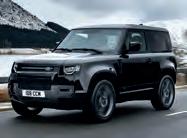


















IN GREEK MYTHOLOGY, THEIA WAS THE DAUGHTER OF GAEA AND URANUS. The personification of heavenly light, she was associated with sight, prophecy and everything that shimmers.
And with having sex with her brother. Those celestials, huh, the stuff they got up to.
JLR is getting up to stuff too. No, not that kind of stuff. The kind of stuff that involves Theia’s name being used for one of five ‘exquisite curations inspired by ancient mythology and the cosmos’ in the new Range Rover Sport SV Celestial Collection.
Called Gaea, Theia, Io, Vega and Sol, the collection ‘will be offered to selected clients.’ JLR getting up to something even more sickening than having sex with your brother there, then. In the company’s own words, ‘the debut collection from the SV Bespoke Design team features meticulously curated content including bespoke colours and finishes, with 23” wheels, carbon ceramic brakes, carbon fibre bonnets and unique

symbolism throughout the luxuriously appointed interiors.’
We won’t go into all the details of the five ‘curations’ (JLR’s favourite word and, in the context of car parts, a potent symbol of talking out of Uranus), because you’re apt to chew your own hands off. But to give you a flavour of what it’s all about…
Gaea: Themed on The Earth, this is painted matt green and has carbon tailpipes and brake calipers for ‘a natural modern look’ as well as silver birch trim inside.
Theia: Shimmering light is seen in satin grey paint containing a hint of metal flake and 23” champagne gold forged rims, as well as a satin carbon finisher in the centre console.
Io: Pronounced as in ‘I owe the bank a small fortune after my new SUV depreciated by a twice my salary in a year,’ this is painted bright orange to represent the similarly named moon of Jupiter, which is more volcanic than a Range Rover owner who’s just had their insurance quote.
Vega: Tottenham Hotspur spent a billion quid on building a new stadium, haven’t won anything for a decade and a half and famously managed to come third in a two-horse race for the 2016 league title, and this is one of two curations named after the club’s former centre-backs. It’s blue, like 2016 title winners Leicester City, and while Ramon Vega did actually win
something with Spurs in 1999, JLR says that actually the name comes from the Arabic al-nasr al-wāqiʽ. We refer you back to our previous comment about Uranus.
Sol: Another Spursy special, Sol Campbell gives his name to a Range Rover with a yellow paint finish. So maybe it’s named after Mexican beer instead, actually. Oh, it’s ‘a representation of the Sun which has always served as a powerful symbol of life and divinity,’ sorry. Black wheels and blue calipers reference the financial state of Macclesfield Town and Southend United during Campbell’s spells as their manager, and you can choose between these two colours for the interior too.
Whichever of these five Celestial themes you go for, JLR has stepped it up a notch with its use of the ‘curated’ thing – around the interior, you’ll find badges saying Sol Curation, Gaea Curation and so on. All very fancy, though at £171,600 even for a nonCelestial SV you may well prefer to say stick it up Uranus.

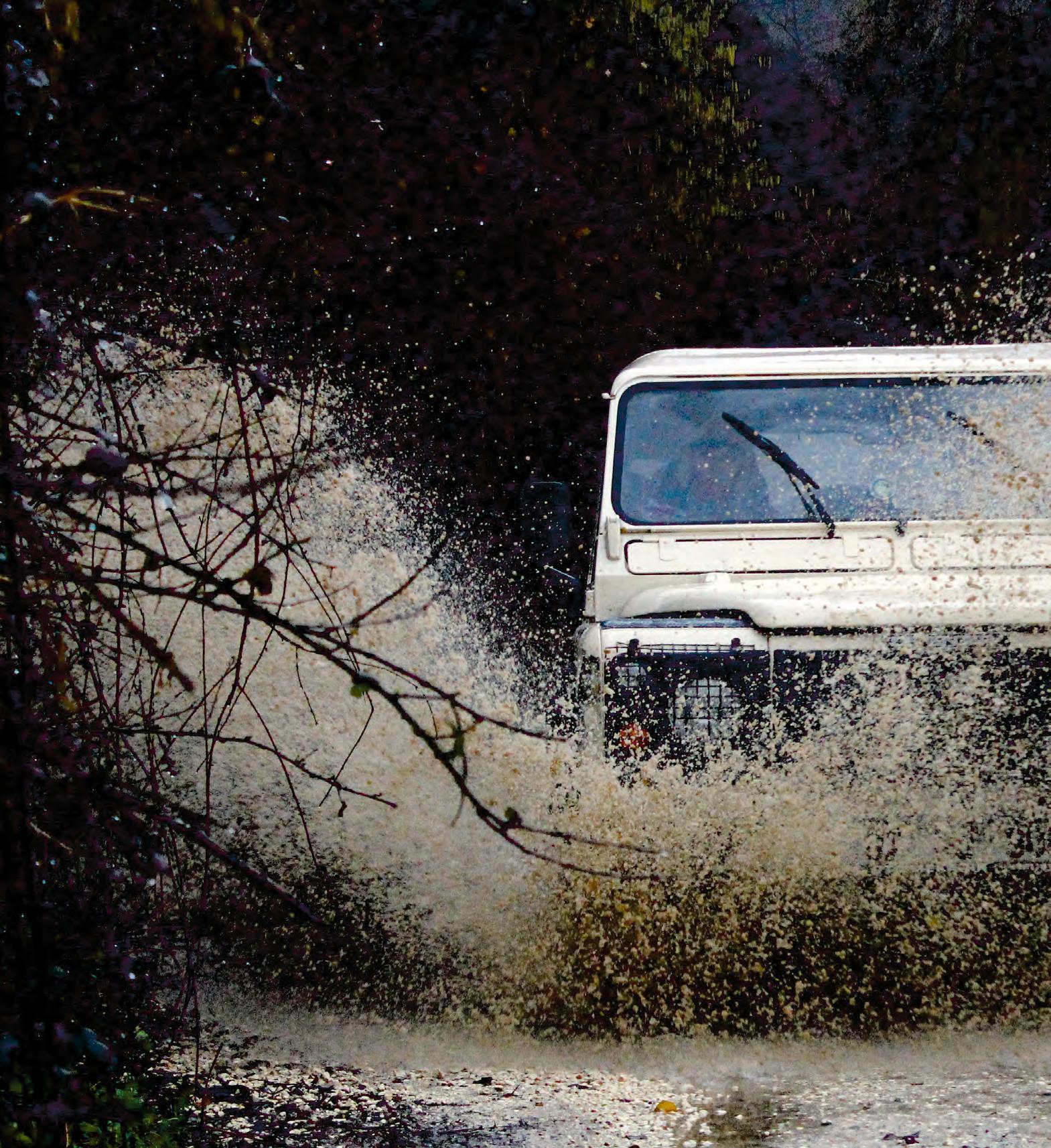




WILDPEAK A/T TRAIL


WILDPEAK R/T01
Wildpeak A/T Trail - Rugged Crossover Capability
Built for adventure delivering rugged off-road capability without compromise on the open road. Featuring the Three-Peak mountain snowflake, the Wildpeak A/T Trail encourages adventure seeking crossover owners to discover true all-weather capability.
Wildpeak R/T01 - Bold, Rugged Terrain Capability
Developed for 4x4’s and SUV’s this tyre sets the standard for the new rugged terrain tyre category. Providing the tenacious off-road traction of a mud tyre while retaining the tread life and stability of an all-terrain, professional Off-Road tyre with POR marking. For further information and to find your local stockist please visit www.falkentyre.com/en or www.4site4x4tyres.co.uk








We give form to our components by machining detail into them with chamfered edges and rounded corners, under cuts, engraving and much more. We take time with care and attention to detail to ensure we deliver quality products. Our products have become a feature to many Land Rovers worldwide.




Alongside our aluminium interior and exterior trim range, our Special Order Service offers leather trim which can be designed to your requirements incorporating our colour anodised parts, to give you the ultimate Enhanced by Croytec Defender.


PEOPLE GET INTO OFF-ROADING FOR MANY REASONS. Work, mates and time in the Army are three of the most common ones, but the biggest of them all is of course transfer case sump covers.
If you’re nodding your head in agreement, which is surely the case, and if your 4x4 of choice is a
Defender, a Discovery 1 or a Tdi-engined Range Rover, which must also be fairly likely, this is going to work for you on all the levels. It’s not just a sump cover – it’s a billet transfer case sump oil cooler, complete with fans to help dissipate heat in the sort of conditions that cause it.
Designed as a straight replacement for the sump covers supplied as standard equipment, this unit is also stronger than the original. It uses the existing bolts for installation, however you do get a new gasket with it – as well as a plugged port, allowing an oil temperature gauge to be fitted. In addition to its extra strength, the cover adds about half a litre to the vehicle’s oil capacity – without compromising its existing ground clearance. Britpart, which supplies the unit, says it can also work on the Rover V8 engine, but that first you need check for clearance behind the existing exhaust pipes.

































































































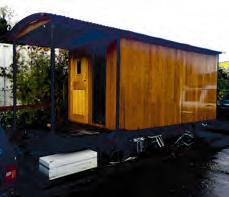





Price: £45.81 inc VAT
Available from: maltings4x4store.co.uk, TF1753R
A COUPLE OF ISSUES BACK, WE INTRODUCED TERRAFIRMA’S NEW CLOSE-FIT ROOF RACKS FOR THE NEW-SHAPE DEFENDER 90 AND 110 and highlighted a variety of accessories the company is offering to help you make the most of it. Well, here’s another one.
It’s called a Terracan. As was a large Hyundai from about two decades ago
that was based on the Mitsubishi Shogun but didn’t look as nice, which you may well feel is quite an achievement.
This isn’t based on anyone else’s old technology and apart from being cheerfully bright red, all it does is hold liquids. That can be water or indeed anything else a person might want to carry, though since its capacity is 6.5 litres we don’t think you’ll be keeping
an emergency supply of balsamic vinegar in it.
The Terracan is designed to lock on to one of Terrafirma’s roof racks, which in turn is designed to lock on to the new Defender. So actually a nice balsamic might be more relevant than you think. Perhaps they’ll also do with with an extra compartment for truffle oil and a kopi luwak dispenser on the end.
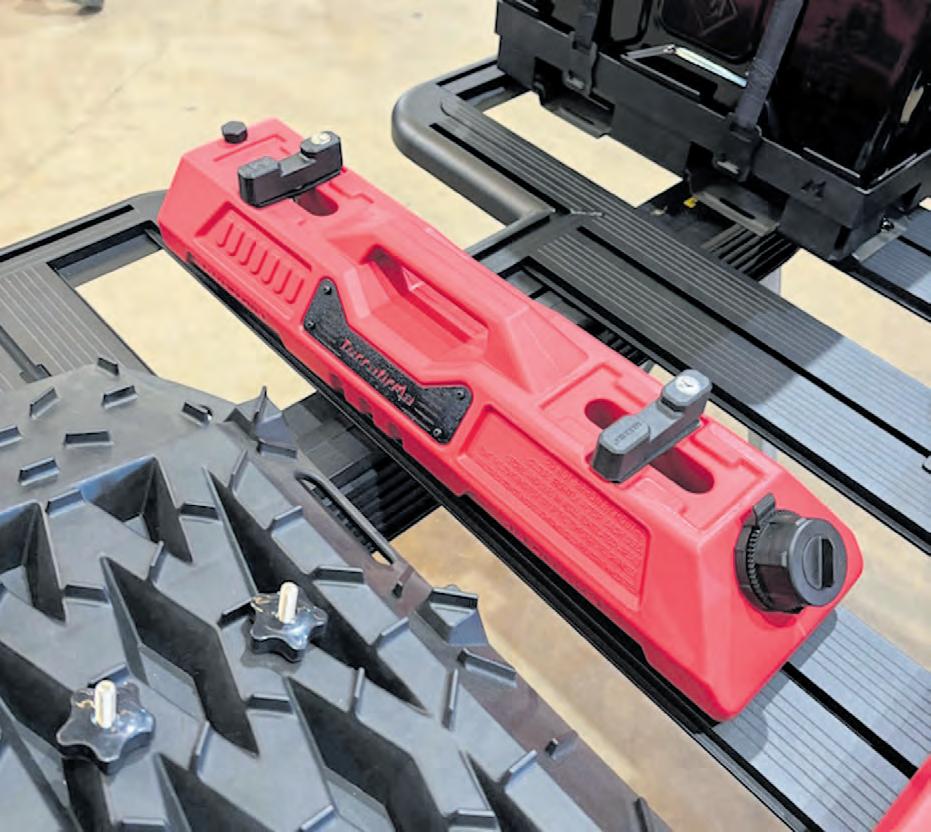


































‘The Hindon’ by Heritage 1948 has been developed after customer demand for a 15” Wood Rim Wheel with a Satin Black Anodised Body. 'The Hindon’ joins our ever growing range of exceptional quality wheels.
The Hindon 15” Wood Rim by Heritage 1948 has been developed around the classic spirit of the Land Rover and continues our uncompromising commitment to quality aftermarket parts. The Satin Black Anodised Body of the Steering Wheel is forged from durable 6061 Billet Aluminium. This is contrasted by a crafted Beech Wood Rim and nished o with 9 Polished Structural Metal Rivets. A Steering Wheel guaranteed to improve the interior of any Land Rover Series or Defender.
Heritage Wood Rim Steering Wheel 6061 Billet Aluminium
Beech Wood Rim Black Anodised Body 48 & 36 Spine Boss Kits
Product Code: HER-WH-05
+44 (0) 1948 545132
INFO@HERITAGE1948.CO.UK

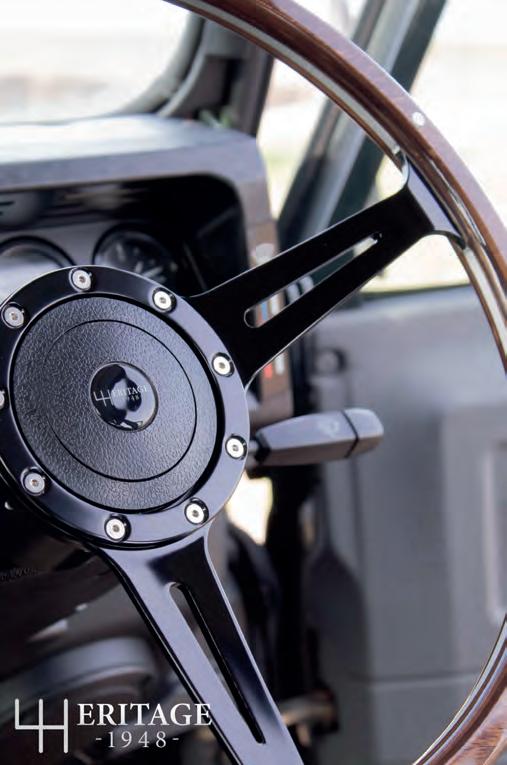
Heritage 1948 is dedicated to producing a range of outstanding quality Canvas Hoods for Series Land Rovers. Unlike some of our competitors, all of our Land Rover Hoods are handmade in our Somerset factory from superior quality ‘Moorland’ Canvas.


Our handmade Hoods are inherently more accurate than machine produced counterparts, allowing for an enhanced t and exceptional quality control. Heritage 1948 has taken great care to ensure all our Land Rover Hoods have an enhanced life span and are all nished with period correct Solid Brass ttings.

To advertise in The Landy, call our team on 01283 553244

We’re on Facebook: www.facebook.com/thelandyuk

The Newark edition of the Great British Land Rover Show was back this June after a year off. And there was a particularly strong collection of interesting vehicles on display as the sun shone and the temperatures climbed

It might be hard to believe, as we sit writing this with the rain pouring down outside, but the weather was beautiful a few weeks ago. And it peaked to perfection for the Great British Land Rover Show at Newark on 23 June, when a bumper crowd turned up to enjoy an equally impressive array of show vehicles both with a busy exhibition hall and on the lawns outside. Even the car park was like a show in itself, with no end of Land Rovers to be admired – from the recently off-roaded to the pristine, from old to new and from standard to wildly and at times uniquely modified. Look out for a couple of the trucks we spotted here in future issues!
Beyond the entry gate, the first thing visitors were confronted with was a
display of ex-AA Landies – their yellow paintwork looking particularly splendid in the sun. Beyond them, the VIP parking area provided an exceptional variety of Land Rovers, lined up and ready to be admired. Defenders to the fore, naturally, but we also spotted some beautifully presented Series trucks, a 101 and a 110 Wolf getting right into the spirit of it with a netful of camo up top. There were some tidy Discos in line, too – while the star of the show in most people’s eyes was a heavily patinated Series IIA Pink Panther complete with ammo boxes and deactivated machine guns.
The horns on the Walker Components stand certainly weren’t deactivated, on the other hand, which led to one or two moments of hilarity when
people tried them and everyone else took off. Fortunately, the Nomad Coffee Company’s 110 was on hand nearby to help calm everyone’s nerves.
Those were among those outside, joining forces on the grass with a great range of clubs and more exibitors – one of the most eye-catching being Black Paw, whose street-look L663 110 was getting no end of attention. Another one to watch out for very soon in next month’s issue of The Landy.
The blue sky did cloud over as the day drew on, though even then the air stayed as warm as the atmosphere throughout. It’s already feeling like that was summer, and now it’s autumn – in the hall, around the site and beyond the car park on the off-road course, this was a hot show in more ways than one!






Left: RIG Automotive is a regular at the Great British Land Rover Show, having first exhibited at Newark two years ago. The company’s boutique campers demonstrate its imaginative approach to converting vehicles – both the









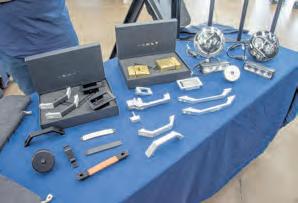



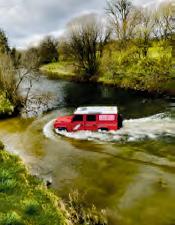



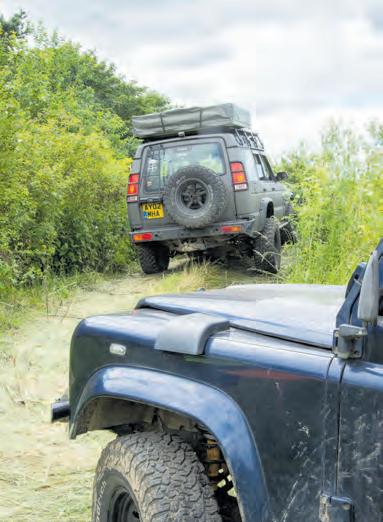







Constructed from tough LLDPE plastic, the Terra Cans are easy to carry & store. Suitable for petrol, diesel & water, making them perfect for all off-road & outdoor activities.
Included is a ratchet lock cap, preventing the cap from accidentally opening. The integral pouring spout & breather vent reduce pressure and make pouring quick and easy.
Available in a variety of sizes, each Terra Can is supplied with either lockable or screw type mounts. The Terra Cans can be stacked and paired with our Terra Can accessories.

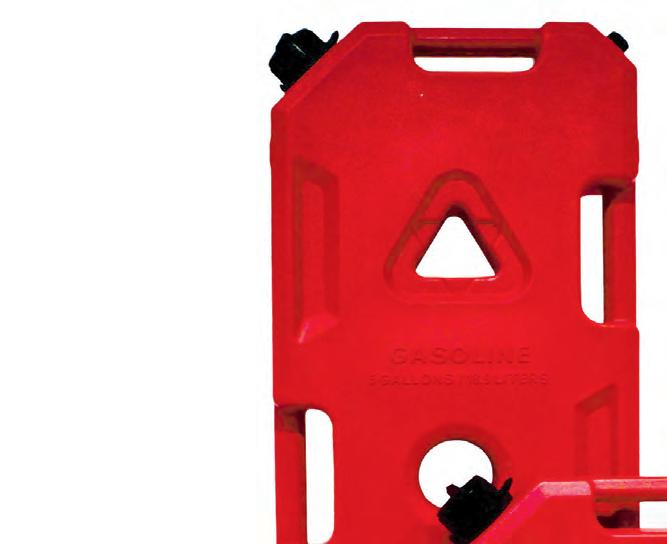

TF1750R TF1750B 3.5L Flat Single Mount
TF1751R TF1751B 7.6L Flat Single Mount
TF1752RTF1752B 19L Flat Double Mount

Single Triangular Lock
Single Triangular Lock
One Triangular Lock & One Triangular Screw TF1753RTF1753B 6.5L Long Double Mount



We’re on Facebook: www.facebook.com/thelandyuk To advertise in The Landy, call our team on 01283 553244


Arctic Trucks started out making vehicles better suited to off-road use in the snowfields and glaciers of Iceland. In doing so, they unwittingly created a look people have been longing for ever since – and the company’s AT35 conversion for the Defender 110 captures it better than any other

Making Land Rovers look bigger is all the rage. The bling Defender craze may have peaked, and values of original-shapers have dropped from the insane heights they reached a couple of years ago, but there’s a new fashion on the street. Taller and wider.
You know the look. The aftermarket is all over it, and so too are several OEMs. Land Rover itself, for example – the new Defender Octa is engineered to within an inch of its life to perform like a supercar, but mainly people are going to buy it because of the way it looks. More aggressive, chunkier… but mainly, it’s taller and wider.
The Octa is also the first Defender ever to leave the factory on 33” tyres. Gasp. Do you remember when those
were big? Margaret Thatcher was Prime Minister and everyone else was on 7.50s.
At around the same time, Toyota’s Icelandic importer started noticing that a huge number of its 4x4 customers were putting brand new vehicles on much bigger tyres in order to cope with the conditions there. So they set up their own workshop and began offering re-engineered Hiluxes and Land Cruisers – with overwhelming results. Soon, up to 70% of the new 4x4s coming in to Iceland were being modified before delivery.
In 1996, the company’s re-engineering arm, which has until then simply been called Toyota Accessories, was given a new name: Arctic Trucks. It continued to be part of Toyota Iceland
until 2005, when it became fully independent and started working with other manufacturers too. By now it also had an operation in Norway, and since then it has expanded to add divisions in Finland and Sweden, Poland, America, the UAE and Britain.
Obviously, the off-roading need for Arctic Trucks’ conversions is marginal at best in these countries, and in the main completely absent. But in converting a 4x4 to suit being operated at low tyre pressures on terrain like snow fields and glaciers, what do you do?
You make it taller and wider.
And you give it much bigger tyres. The conversions on offer go all the way up to 44”, which is available in both four and six-wheel drive form. Obviously, though, there’s a colossal amount of














engineering work (and therefore cost) in that, so most customers go for the AT35. As the name suggests, this sits on 35” rubber – various sizes are used, but a 325/60R20 is typical. That’s what’s standard on the company’s latest creation – the Defender 110 you see here.
In the pipeline ever since the new-shape Defender first came out, the vehicle ‘has undergone extensive development with Arctic Trucks’ experienced team of off-road mobility specialists to allow it to handle challenging and inhospitable landscapes with even greater ease.’ They’re adamant that this is a serious off-road conversion, of course – but they’re not hiding from what most people want it for. ‘The Defender AT35 benefits from greater ground clearance, articulation and increased approach and departure angles,’ they point out. ‘But let’s be honest, these enhancements also look utterly fantastic!’
Admitting that people buy Land Rovers for their image rather than their ability is something Land Rover itself
has not always been very good at. But of course, as with all cool cars, the ability needs to be there. Only a fraction of supercar owners take them to track days, for example (most just hope it’ll get them laid) – but anything that looks like a Ferrari but goes and handles like a knackered Mondeo will soon be laughed off the street.
The same goes for vehicles that look like hardcore off-roaders but aren’t. We all know that guy who put huge tyres on his Defender but found that an old 2.25 could barely turn them, or smashed a diff every time he went round a corner, or sold it again in horror after learning an ugly lesson about brake fade. None of that would be alright, and not would a vehicle that shakes, bumps, drones and roars. I’ve driven an AT44 and while you do of course know all about the size of its tyres every time they hit a bump, it’s nowhere near as intimidating as you might expect and the vehicle’s refinement was hardly affected at all. By contrast, I’ve also driven a badly modified 4x4 on 33s and it was almost uncontrollable.
So, the AT35 needs to be just like driving any other new-shape Defender. Or better, when you take it off-road. But people who buy one won’t.
How do we know? Because we asked the man from Isuzu, which has been selling the D-Max AT35 as part of its full main dealer line-up for almost a decade. Back when they launched it, I asked him if he thought customers would buy it for its ability or its looks.
‘Wellll,’ he said, with a half smile, ‘I hope they’ll use it off-road.’ Same question a couple of years ago: ‘They buy it as a second or third car because they like the way it looks.’ No doubt, no bull: it’s all about the image.
And that’s with a traditional off-roader. The Defender might be an off-roader, and a pretty good one in its own very electronic way, but people buy them to be an up-yours school-runner. And there’s a strong aftermarket making them a little taller, a little wider and a lot chintzier for customers who want to say no, up YOURS is what.
And then there’s the AT35. It might cast a passing glance at all that silli-
ness and laugh quietly to itself, but it’s for the guy who wants to rise above it. Literally. Or, to put it another way, it’s for the guy who wants to turn up to a pop-gun fight with a Howitzer. In Arctic Trucks’ own words, it’s ‘the most cool, capable and stylish Defender available on the planet.’
Many of you reading this will say that actually, a farmer-spec 200Tdi 90, or a soft-top Wolf 110, or perm anything from a million possible oldshapers, is the coolest Defender on the planet thank you very much. But if you were forced to buy a current SUV, a Defender is without doubt the one you’d choose. And if you could stretch to it, an AT35 conversion is probably the way you’d go about making sure you weren’t mistaken for a tragic school-runner trying to one-up their fellow mums.
So what would you get? Starting with the fundamentals, you’d get a Defender with its original suspension lifted by +15mm. That’s about three-fifths of an inch. As an option, you can instead choose a replacement set-up using
adjustable 10-position Bilstein front coilovers and rear springs and shocks; this hikes the lift to +20mm, so now you’re looking at more like four-fifths of an inch.
More important than the lift, though, is the fact that it allows for those tyres – 325/60R20 BFGoodrich KO2 AllTerrains as standard or, a no-cost option, the same company’s KM3 Mud-Terrains in 35x12.50R20. In each case, these are fitted on Arctic Trucks’ own forged 20x10” ET-25 dual-valve alloys in satin black.
Does less than an inch of lift really allow the Defender to take a 35” tyre? You wouldn’t expect so on its own, but Arctic Trucks has always believed in gaining lift from every available source – in other words, not putting all its eggs in one basket. The aforementioned badly modified truck on 33s had an 8” suspension lift and nothing else, whereas those AT35 Isuzus have a little in the suspension, a little in the body mounts and a little in the wheelarches, and they drive almost like standard.




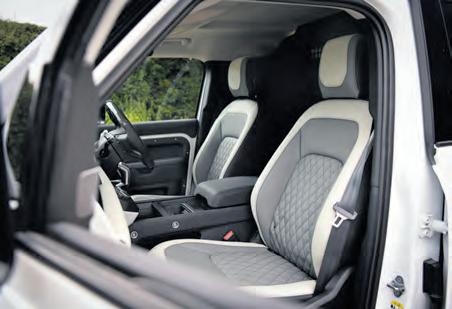
In the case of the Defender, the Arctic Trucks package includes ‘extensive re-engineering and metalwork to body and bodywork’ and ‘widened fender flares featuring a recessed Arctic Trucks tyre pressure detail.’ So, a virtual lift to go with the actual one. And while buying in suspension from Bilstein and tyres from BFG can’t have been cheap, this is where the biggest part of the price is going – anyone can bash a hammer against a set of wheelarches until their tyres don’t rub any more, but it takes skill to do it so it works, it looks right and, critically, it’s repeatable.
The Arctic Trucks detailing on the arches is not the only example of the company’s badge you’ll find around the vehicle. Indeed, the spec list also includes a ‘badging and detailing package, on the grille, doors, side steps, tailgate, wheel centres, mud guards, interior mats and number plate surrounds. You get an Arctic Trucks
30th Anniversary decal, too, as well as a certificate of authenticity to say this is a real one.
Also included in the AT35 package are heavy-duty aluminium side steps, bigger and stronger mud guards, rear recovery points, locking wheel nuts, carpet mats and Arctic Trucks’ Obsidian Black styling pack – which includes trims for the front and rear bumpers, the side panels and the grille. They re-calibrate the truck’s speedo to suit its new wheels, too – and, just in case you have a warranty claim and the Land Rover dealer starts strutting around like an excited traffic warden who’s just discovered Pornhub, a choice of warranties.
You want more? Options include a bespoke leather interior (seats, doors, dash, centre console, steering wheel) featuring debossed Arctic Trucks logos, a tailgate mount for the spare wheel and a roof-mounted Lazer Linear-42 Elite LED bar.
Lots of ways to add to the final bill, then – which, since you’ve already bought a new car from Land Rover, will not be an unfamiliar feeling. Neither will the reassuringly expensive price on the package as it comes, which is £29,995 plus VAT. Not cheap, but when you’re after someone to make engineering upgrades to a vehicle that’s already cost you the thick end of a hundred grand or more, there’s a fairly strong argument for saying cheapness is unlikely to be high on your list of must-haves. Three decades of heritage, on the other hand? I refer you back to that comment about when Margaret Thatcher was in Number 10. It feels like a long, long time ago, and indeed it was – but that’s how long Arctic Trucks have been perfecting their art. There are cheaper ways to make a Defender look taller and wider, and some of them are good value for money. But with the AT35, you’re getting an awful lot more than just a set of parts.




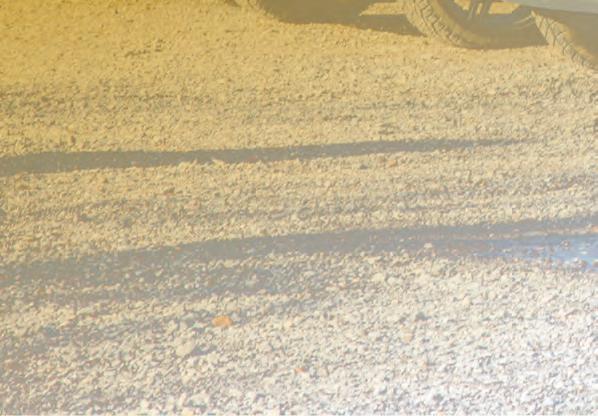


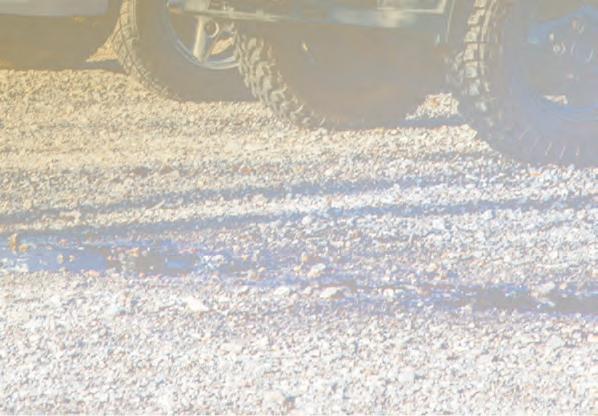




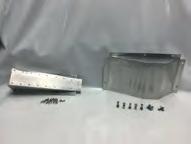
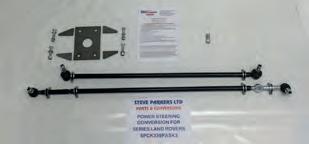












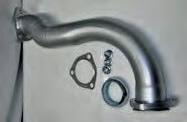











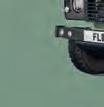






The Discovery 2 is not fondly remembered. Its chassis and bulkhead rust, its sunroofs leak, it has air suspension and its electronics are, well, electronics – but it was the last Land Rover aside from the Defender with proper axles.
Series I (1948-1958)

It had a real handbrake lever, too, and a transfer case you worked with a stick.
So if you want a Land Rover with all the right hardware but a bit of comfort and space, it’s the go-to choice these days.
The Td5 engine is the one you’ll think of first, with its strong performance and
all Land Rovers. Its engineering and design give it real charisma, but parts aren’t readily available. Restoration projects require deep pockets, but see it through and the result will be worth mega bucks. Gone are the days where you could use a Series I as an actual Land Rover. Because with restored examples changing hands
Series III (1971-1985)


These military vehicles can easily be distinguished from regular

terms, keeping the same 2.25-litre engines throughout the length of its production run. In 1980, the engines switched to a more durable five-bearing crank rather than the old threebearing setup. The transmission also received syncromesh on all forward gears to make it easier to live with.
Land Rovers. To mimic the civvy Series machines, the Series III model built from 1972 onwards, also had its headlights switched out to the wings. Lightweights add an extra dimension to owning a Land Rover. Their military history and details mean you get a truck with more stories to tell – and that stands
reliability. But it can be hard to find one that hasn’t been tuned – perhaps well, but woe betide you if you get one that’s been done ham-handedly (which is how it will have been driven, too).
That’s why the 4.0 V8 is worth a bit of consideration. It’s puny for what it is, but it makes a nice noise and it too is a lump you can trust.
Sadly, like all other Disco 2s you’ll be riding with the Three Amigos – those
£5000-£85,000
for millionaire money, preservation is the aim of the game.
The earlier the vehicle, the more it will be worth. The sky’s the limit – but can you really put a price on such an icon?
Pros: Heritage, charm, a true classic, the original Land Rover Cons: Availability of parts, price tag on early 80s
£2500-£30,000
They still carry the simplicity of earlier Land Rovers, but can be obtained for a fraction of the price... for now.
Pros: Most affordable way into Series ownership. Still has the Series pedigree. Parts still widely available
Cons: Not yet as desirable as the earlier Series models

electronic dash lights that mean you’re about to get poorer fast. But compared to what’s come since, this is still a Land Rover the way they used to make ‘em.
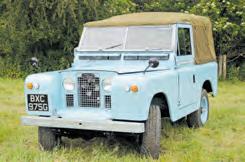

Forward Control Land Rovers are a cult within a cult. They’re a real
much of that early charm. Prices are on the increase, however, as these vehicles start to come into their own as collector’s items.
A 2.25 petrol 88” would be our pick, as the diesel engines were underpowered and rather noisy.
The Series II/IIA has a wider stance than its predecessor and adds an extra (thin) layer of
rarity – with all the cachet, pride and immense awkwardness that comes with this status.
By ‘rare’, we’re talking about less than 2500 Series IIA FCs in total. And they tended to have a very hard life, so not many have survived to tell the tale.
Forward-Control models differed from everyday Series IIs by
a Discovery 2 4.0 V8 with Adrian Flux from £357
• Based on a 2000 V8 GS auto with off-road mods. Valued at £3000, 5000 miles a year. 50 year old driver, fully comp, £500 excess
£2500-£45,000
refinement. While the engines have excellent longevity, they need to have been maintained properly. Be thorough in your checks, both under the bonnet and underneath the body.
Pros: A sound investment to restore – and enjoy
Cons: Bulkheads and chassis rot, springs prone to seizing
having heavy-duty ENV axles, but engine-wise they had the familiar 2.25 petrol and diesel lumps. So, don’t expect performance – but do expect to be given an ‘interesting’ time in the workshop…
Pros: A Land Rover like no other, if that’s what you want Cons: Especially brutal to drive, and to find parts
out from the crowd. They’re a rare breed, though – so if you’ve got one, it’s worth keeping hold of.
Pros: Not like all the other Land Rovers out there. Military background. Lovely 2.25 petrol
Cons: Appearance isn’t to everyone’s taste. Exclusivity over regular models means they command a price premium

when the time came for demob. They were flogged off at very low prices and turned into off-road toys –not something you’d do with one today, given the rarity and classic value they’ve taken on.

Compared to the IIA/IIB FC, the 101 is more fun thanks to its V8 engine. It’s still a military tool, though – some still have fixtures
and fittings from their Army life, which adds interest. This is a vehicle for enthusiasts, though, with costs that are sky-high even by Land Rover standards.
Pros: Master of the road. Lovely V8 soundtrack. Everybody who sees one loves it Cons: Monumental running costs.

























































































































The Tdi engine, which arrived with the Defender name, can last for

decades if it’s looked after. Find one that’s had all its oil changes (a tall order) and it’ll go round (and round) the clock.
The good thing about the earlier 200Tdi is that it’s simpler than the later 300. What you gain here you lose in refinement, but this is seen by many experts as the best Defender of them all.
the two are related. It’s much more refined and smoother to drive, though there are more electronics involved so later versions in particular are less of a DIY fix.
The LT77 gearbox in the 200 Tdi is more truck-like than the later R380, and these vehicles didn’t come with bling. Just be sure it’s an original Tdi you’re getting, not an old Discovery conversion.
Pros: The perfect combination of tradition and modernity
Cons: Lots of horrible and/or deceptive ones around

130 that changed the most. That’s because unlike the old 127, it was built on a proper chassis of its own rather than a stretched 110 frame.




The advent of the Tdi engine was the making of the 130, too. At last, Land Rover could make them pull properly without returning single-figure fuel economy by using a hard-worked V8. As a result, you’ll find many more original(ish) 130s than 127s. Some are even still in service with the utility companies they were built for. If you want a Defender for overlanding, look no further. Pros: A proper truck with huge capabilities in every area Cons:
become sought after for their light clutch and better shift action.
It was during the Tdi era that Defenders started getting things like alloys, too. You might even find one that’s not been off-road…
Pros: Strength and simplicity.
Cons: Sure to be very different to when it left the factory Defender 300 Tdi (1994-1998) £4500-£43,000
The arrival of the 300 Tdi also brought with it the R380 gearbox. This used to have a terrible reputation for relability, but most have been put right by now and they’ve

The last Defenders gained modern
and 2.2 TDCi engines and
smooth six-speed gearboxes, They still had phenomenal off-road ability and were even okay to sit in. Famously, this was the Defender that actually had a dashboard Many people dislike the TDCi, especially the earlier 2.4, but they still change hands for huge money – especially when the likes of Kahn or Twisted have been
Perhaps the definitive Defender

The
and it’s
involed. You will always pay a premium for a Puma, and a Tdi or Td5 may turn out to be a better purchase. Even then, though, look after it and you may well never see depreciation.
Pros: Efficiency, creature comforts, off-road prowess
Cons: Price, electronics, TDCi engine is unloved

If the subject of the new Defender comes up in enthusiast circles, try






a strong performer. It does lend itself to being tuned though, so watch out for abused ones and knackered examples that have been pushed beyond the limit.
As with all Defenders, you’ll need a rear crossmember sooner or later – or even a new chassis.
Despite having more electronics than the Tdi, a Td5 Defender can
£55,000-£165,000
to steer it away on to something safer. Like Brexit, for example.
Much as it may infuriate purists, however, the Defender is actually a very wonderful thing. It’s kind of like an old one, only with space, comfort and equipment.
The big difference is that you can’t work on it yourself. This goes for maintenance and, crucially,






making modifications – a market Land Rover wants to take back and have for itself. It won’t hold its value long-term the way an original-shaper does, either. But this is still a superb vehicle.
Pros: Comfort, capability, rugged fitness for purpose
Cons: Not cheap to buy. Lacks the old one’s basic charm















It’s also a notable classic in its own way, as it heralded the start of the company’s modern era. It has its issues, though. The viscous coupling is expensive to replace and can be upset simply by running mismatched tyres.
The 1.8 petrol used to be notorious for head gasket failures. Today’s replacements are much
more robust, but a late diesel is your best bet. Even these can go calamitously wrong, though. This was a more complex car than it needed to be, and buying one for sweeties now doesn’t change that.
Pros: Cheap to buy, no big rust issues, surprisingly able off-road Cons: All sorts of things can go wrong, some very expensively
Range Rover Classic (1970-96) £4000-£275,000

The




2 (2006-2015) £2000-£17,500
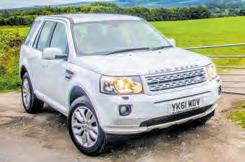
The Freelander 2 was a massive improvement on the model
it replaced. It’s a refined and affordable SUV with a strong engine, good equipment and a decent level of practicality.
It’s become one of the most reliable Land Rovers out there, too.
But do be aware of the rear diff and Haldex unit for costly outlays.
The 2.2-litre diesel engine is a strong performer, though for a
bargain search out one with the unpopular 3.2 petrol unit. Either way, it’s a fine SUV to drive.
Prices have fallen since the production ended, too – £10,000 now gets you one worth having.
Pros: Reliability, refinement, economy of diesel engine
Cons: Transmissions can wear quickly if used for towing
is a classic you can use everyday – and there are people who do just that, preferring to invest new-car money in a restoration than spending it on a current model.
It’s a smart policy, too. An early two-door can cost mega money, but any Classic will appreciate in value if kept in good condition –and sought-after rarities like the CSK and LSE can be a gold mine.
Range Rover (2002-12)
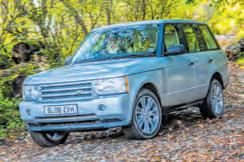
The Mk3 Range Rover hit new heights of luxury and was more re-

The
Range Rover
liable than the P38. It’ll still cost a lot to run, however, and drivetrain faults and underbody corrosion are not unknown.
The TDV8 engine is sublime, but you’ll pay more to get one –especially the 4.4, though the 3.6 has all the power you need. The V8 petrol, on the other hand, is temptingly cheap. Guess why…
to greater extremes than ever, with lavish equipment and endless opportunities for personalisation.
It’s a supreme lifestyle wagon for the rich: to many of Land Rover’s traditional fans, on the other hand, it’s the supreme irrelevance.
If you can afford one, few cars could be as pleasing. However if you can afford one and you love
An awful lot of Rangeys have been neglected and/or abused, and you can still buy they cheap. But if you’ve got the skills, and access to parts, restoring one would be the ultimate hobby that pays.
Pros: Most usable classic Land Rover, V8 power, ride quality
Cons: Rust, availability of parts for early models
£2200-£27,000
This isn’t a DIY motor, but it certainly is a Range Rover, with brilliant off-road and towing skills. It relies a lot on electronics, but they work wonders – and the deepdown engineering is very robust.
Pros: Great off-road, luxury, image, TDV8 powerplants
Cons: Very complex. Huge running costs
Land Rovers, you’re likely to be thinking about how many real ones you could buy with this sort of money. It wouldn’t make a bad way to tow your collection about the place, though…
Pros: Immense prestige, and sublime both to be in and drive
Cons: To at least 99% of people it’s utterly divorced from reality
Range Rover Sport (2013-22) £19,500-£140,000

The second-generation Range Rover Sport is 400kg lighter than

the original, meaning it’s almost economical to run. It feels really nimble and agile on the road, too, and it comes with a range of engines giving it a brisk turn of pace. Some won’t like the flamboyant posture, while others will love it. Either way, inside the cabin it’s very nearly as luxurious as the full-fat Range Rover.
the masses. Given that it was the company’s fastest-selling vehicle, they clearly hit the brief, even if it wasn’t for the traditional Land Rover owner.
It’s actually still a capable thing off-tarmac – but it’s definitely more at home on the road.
Nevertheless, it is economical by Land Rover standards and
The only stumbling block with such a fine motor is going to be how to pay for it. Depreciation has started to bring down the purchase price – though you’ll never run one on a shoestring.
Pros: Performance, refinement, glorious interior Cons: Marmite image. Pricey to buy and run
because there are so many out there, used prices are tempting. There’s a Convertible model, too, as well as three and five-door

working order is still a sensational car to
own, even today. The problem is that they’re very complex and very, very good at going wrong.
Air suspension failure is the norm. Head gaskets can let go.
Electronics are laughably flaky. And parts can cost the earth – as will the labour bills. Perhaps worst of all, nowadays it’s very hard to find one you can be sure hasn’t
spent at least part of its life being worked on by idiots
Still, you’ll get a classy motor with proper off-road and towing skills. It’s becoming a classic, too, and prices are still tiny considering everything you get.
Pros: Luxury, price, a Land Rover that doesn’t rust Cons: Electrics. Be very afraid
Range Rover (2012-22) £20,000-£150,000


range supply copious amounts of power, and its road manners are absolutely impeccable.
It’s startlingly capable off-road, too, even if getting one muddy would feel like bad form. Most that leave the tarmac probably do so only when their owners are in the mood to blow some grouse out of the sky.
a supreme off-roader as well as being a funky road ride. It doesn’t handle like a sports car, but is agile enough for an SUV.
A Discovery of the same era is far more practical, however, while a full-fat Rangey has more class.
Inside, the Range Rover’s cabin is superb, with sumptuous trim and cutting-edge equipment. Prices are, of course, as immense as the vehicle itself. But if you can afford it, so too is the presence a Rangey will give you.
Pros: Class, luxury, engines, vast all-round capability
Cons: Price
You’re looking at a car which many people associate with rich chavs and criminals, however. And being based on the Discovery 3, it can’t help but share that vehicle’s reputation as a money pit.
Pros: Decent performance and all-round dynamics
Cons: A Disco 3 is more usable. Expect horrific running costs Range Rover Sport (2005-2013) £2500-£20,000
The Sport is mechanically similar to the Discovery 3 – meaning it’s

The Sport is still a massively able tow barge, though, in addition to all its other virtues.
new Range Rover. The Sport is less about being chauffeur driven and more about lording it over other aspirational school runners, but once again it’ll be lovely to drive.
Like the full fat Range Rover (a phrase which has never felt more appropriate), the Sport is available with an old-school V8 engine that gives you racecar performance in

has adopted a similiar back end to the larger Velar. It’s not just the exterior that mimics the looks of the larger vehicle, however, as the Evoque has gained the latest Touch Pro Duo tech and a hike in quality.
The main highlight of the new Evoque is the fact the majority of the range is made up of mild
return for NASA-level emissions. Most UK customers with opt for an altogether healthier plug-in hybrid, but they’ll still get a vehicle that’s brutally fast a well as being able to do the normal Range Rover stuff.
Pros: Smooth, refined, comfy… and game for a laugh, too
Cons: Still hasn’t quite shed its proceeds-of-crime image Range Rover Sport (2022-on) £80,500-£145,000
hybrids, available with diesel and petrol engines combining to an electric motor. Only the base D150 Evoque escapes the electrification,







The Velar a competent cruiser and has received numerous accolades
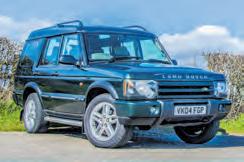
because of its particularly handsome exterior. It’s based upon the same architecture as the Jaguar F-Pace but has greater off-road ability and is available with a wide choice of engines, most of which combine good economy with usable everyday performance.
The interior is Land Rover’s most advanced cabin to date, with
most reliable units ever. It drives well, too – mated to a manual box it has more guts even than the V8 option, which is surprisingly bland but predictably thirsty.
other models expected to follow the Velar in due course.
But is there a whiff of style over substance? Well, it’s a very good SUV. But you don’t half pay a premium for those suave looks...
Pros: Stylish design, chic cabin, excellent tech features
Cons: Feels like an indulgence, especially at such a high price
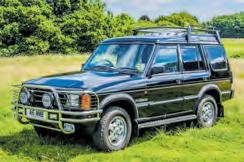
with the same 100” wheelbase and a slick body containing a spacious, flexible cabin. It was well equipped and refined, and it came with the wonderful Tdi engine.
Over time, the Disco’s epic ability meant almost all of them were hammered at playdays. Lower body rust is a big killer, too. So it’s rare to find a good one now,




and when you do they tend to be priced with a lot of optimism.
Very early ones in tip-top condition are full-on classics, too. For a sound one to own, we’d look for a tidy 300Tdi.
Pros: Price, practicality, parts availability. Epic off-road ability
Cons:
been
models had air-suspension, with all the horrors that brings.
Whereas the Disco 1 was prone to body rust, the D2 is fine here. Instead, its chassis rots like a carrot, especially towards the back end. Also at the back, seven-seat

is basically an evolution of the 3. It looks similar and is still a practicality monster, as well as being hugely impressive on and off-road and a hero in front of a trailer, but despite being only subtly tweaked inside feels far more luxurious.
Mainly, D2 owners will tell you about rogue electronics. And leaky sunroofs. They still love their trucks, though, which says a lot.
Pros: Td5 power and reliability, great all-rounder, lots of choice
Cons: Chassis rust, electronics, leaky sunroofs, air suspension Discovery 2 (1998-2004) £1000-£11,000

and capable off-road, genuinely luxurious and a giant of a tow truck, and as well as being able to seat seven adults it can be turned into a van with a totally flat rear load area.
But it was also astonishingly complex, and these days it has a reputation as a money pit.
Air suspension and electronic
handbrakes are big sources of woe, cam belts are a body-off job to change and rust is becoming more of an issue. Get a good one, though, and it’s all the car you’ll ever need.
Pros: Good at everything. Lots of accessories available now
Cons: As fragile as you expect, and then some
start off by buying the best you can possibly afford – and at the top of the market, they don’t come cheap. Get it right, though, and this is as good as a modern Land Rover has ever been.
Somewhere between a facelift and a whole new model, the Disco 4
Pros: Most LR fans’ idea of what a Range Rover should be like Cons: Still a potential money pit, and the best are expensive Discovery 4 (2009-2017) £6000-£30,000
That hasn’t prevented it from suffering all the same issues as time has gone on. You need to

body and dishes up an appealing all-round blend of comfort, kit and general driving manners.The third row of seats is only suitable for little ‘uns, though, and off-road it’s a Discovery in name only.
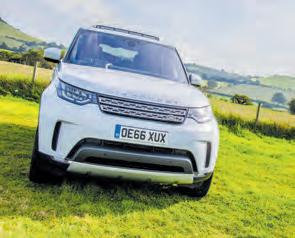
at
launch it was the most capable Land Rover on sale – the new Defender will be going some to wrest that crown from it.
All the engines in the range are refined and flexible, and its chassis is remarkably supple for such a big vehicle. There’s no end of electronics working away in the background, but the effect is very
£24,500-£95,000
convincing – as is an interior that might make you wonder why you’d bother paying more for a Range Rover. Just be careful not to go wild with the options and end up paying more for a Discovery…
Pros: Immense blend of comfort and practicality
Cons: Feels more like a softroader than a proper Discovery
Pros: More practical than an Evoque, and less vulgar. Seven seats. Capable enough off-road Cons: Back seats only for small mammals. Price of top models Discovery Sport (2015-19) £12,500-£33,000
It’s a more practical proposition than the closely related Evoque, and you won’t need to live with the fear of Posh Spice jokes. You


might shudder at the price if you’re buying new, though – but on the used market, there are some tidy looking deals to be had, even on high-spec examples.





of some models




Series IIA 88 (1967). 73,000 miles. 2.25 Diesel. Usable condition, good chassis. Runs and drives. Good steering and tracks straight. Starts every time. Some history and paperwork. £5295. Stonehouse, Glos. 0207 096 5405 08/24/010
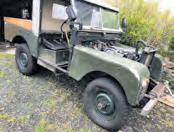

Series I 86” (1955). 200Tdi from 1991 Discovery. Sound condition. Parts thought to be Series I, but gearbox may be Series III. New rad plus some wiring required to finish. Reasonable offers. Anglesey. 07813 298993 08/24/011

Defender 90 Td5 (2004). 14,700 miles. Overland X model by Nene. 185bhp remap, cage, twin 8274s, ARBs, Ashcroft shafts, extreme suspension, split-charge, snorkel. Bluetooth stereo. £19,999. Cheadle. 07792 132288 08/24/002

XS (2013).
miles. Sawtooths, full LED pack, Black Pack, Winter Pack (inc heated screens), NAS rear step. Alpine stereo, custom seats. FSH. MOT May. £32,000. Rugeley. 07464 605139 08/24/007

Defender 110 Td5 HT (1999). 91,000 miles. Three-seater. Front and rear heated windows, 1000W 12V inverter, Eberspacher diesel heating system, reversing camera. £15,500. Whitchurch, Hampshire. 07725 819365 06/24/003

Defender 110 2.4 TDCi camper (2007). 124,500 miles. HD susp. LEDs, Grabbers, 13,500lb winch. Double-height pop-top, fridgefreezer, hob, 60-litre water tank, split-charge. £34,995. Billericay. 07715 591541 09/24/001


Series IIA (1963). 42,734 miles. 2.25 petrol. Good chassis and bulkhead, rebuilt 5MB engine and carb, new clutch, HT system, fuel tank, props. Parabolics. FWH. Clayton heater. £10,650. Bracknell. 07914 840351 08/24/001

Defender 90 HT (2009). 28,000 miles. Soundproofed, 12v leisure adapter, extra passenger seat. Momo wheel. New Cooper Discoverer ATs on Sawtooths. Recently Waxoyled. FSH. £25,950. Solihull. 07976 440110 09/24/003



Series I 88” (1958). Full resto. Solid chassis and bulkhead. 2.5 diesel. Higher diff ratios, taller tyres. Interior heater. Comes with capstan winch, metal sun visor and other parts. £18,950. Corby. 07973 656551 08/24/005

Defender 90 2.4 TDCi (2010). 84,000 miles. Panoramic glass, Red Booster clutch kit, Ashcroft output shaft, Emu shocks, LED headlights, Eberspacher cabin heater. MOT May. £17,995. Rugby. 07740 404574 08/24/009

Defender 90 Td5 Pickup (2005). 67,000 miles. Recent brakes, hubs,
056720 08/24/004

Defender 110 2.4 TDCi camper (2011). 175,000 miles. Dormobile roof, Speedwing awning, ARB compressor, 125-litre fuel capacity. Engine rebuilt and mapped. Emu shocks. £21,999. Marldon, Devon. 07522 552611 09/24/002


Defender 110 Utility (1997). 198,000 miles. Galv chassis, engine rebuild 20,000 miles ago. Winch bumper, +2” lift, rack, BFGs. Spare mount on bonnet. MOT Jan. £6500ono. Dumfries and Galloway. 07754 530271 06/24/006


Defender 110 2.4 TDCi Utility (2011). 157,427 miles. Recent clutch, turbo, transfer case. Exterior lights, adjustable towbar, 7-pin plug, Maxxis 764 Bighorn MTs. MOT Sept. £8995 + VAT. Pwllheli. 07450 654988 06/24/005
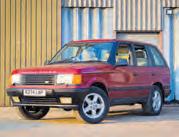

Defender 90 and custom matching camping trailer (1990). Fully restored. Galv chassis, 4.3 Lexus V8, Ashcroft box, LSD, respray, Exmoor hood. Trailer on Penman chassis. No expense spared. £67,500. Corsham. 07718 536118 09/24/009




Defender 130 Single Cab (2015). 31,500 miles. Converted to camper van by Custom Campers of Germany. Full expedition vehicle ready to travel the world. MOT July. £99,000. Sutton Coldfield. 07425 250590 08/24/008

Range Rover monster truck (1973). Suffix A chassis, genuine 92/93 2-door shell. 5.7 Chevy V8 (new in 04), 4-speed auto, modded axles, custom props. 49.00x21R20 Swampers. £22,500. Westerham. 07707 449916 06/02/002

Pre-Production Suffix A Range Rover (1970). Requires full resto. Dry stored since 1988.



















































































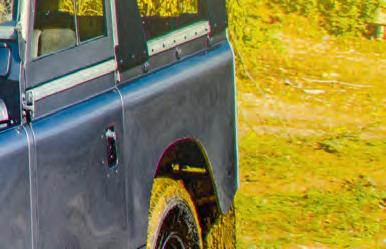
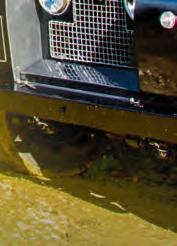


















Britpart performance springs are high quality, versatile and competitively priced - the right choice when replacing the old sagging original springs.
Developed by one of the world’s top spring manufacturers these high quality, powder coated yellow springs have been designed with the needs of today’s Land Rover owners in mind. Britpart performance lifted springs have the added benefit of improving your vehicles approach and departure angles which in turn allows you to overcome more obstacles when offroading.
As Land Rovers are often working vehicles as well as the family car, uprated springs must offer the ability to carry loads, handle off-road terrain and provide a good ride on road. The progressive springs offer a compliant ride when lightly loaded, but firm up as the load increases.
After Lowering

“Britpart performance springs are high quality, versatile and competitively priced...”
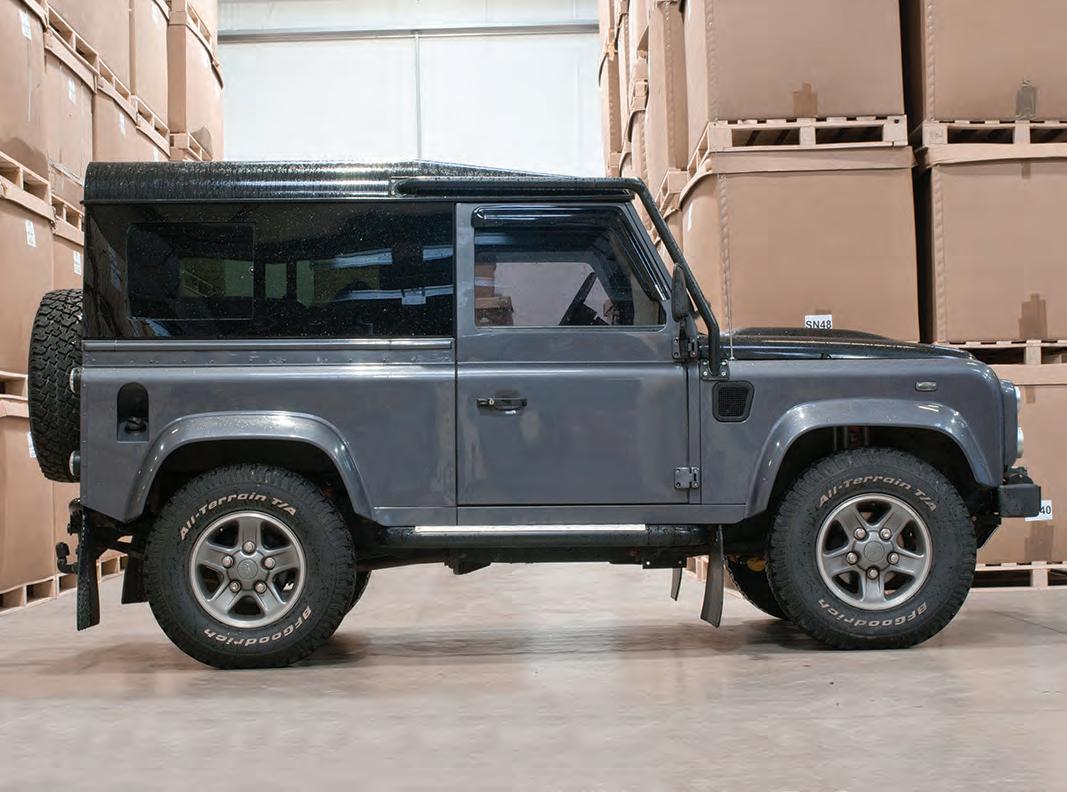
Note -
Britpart yellow springs are designed for the enthusiast who wants a performance spring without having to raise the vehicle. They offer a firmer ride with less body roll, ideal for a vehicle with uprated performance or one used for carrying heavy loads. The springs are designed to offer full articulation off-road with a compliant ride. Developed by one of the world’s top spring manufacturers these high quality, powder coated yellow springs have been designed with the needs of today’s Land Rover owners in mind.
Britpart Performance - 1” Lower Springs Reduce the ride height of your Land Rover by 1” (25mm) by fitting these lowered springs. By lowering your vehicle it will help reduce body roll as well as giving your vehicle a more sporty squat stance. The springs are designed in line with the standard spring rate specification. Finished in powered coated orange paint.
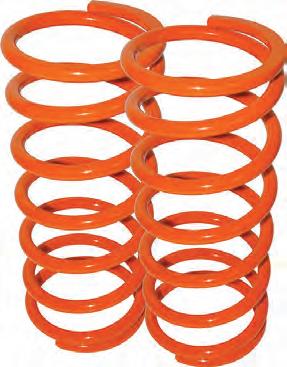
DA4563 Defender 90 & 110/Discovery 1/Range Rover Classic
DA4564 Defender 90/Discovery 1/Range Rover Classic
DA6449 Defender 110
DA1234 XD Handling Kit for Defender 90/Discovery 1/Range Rover Classic Kit contains lower springs, shock absorbers, anti-roll bars, turret rings and more...